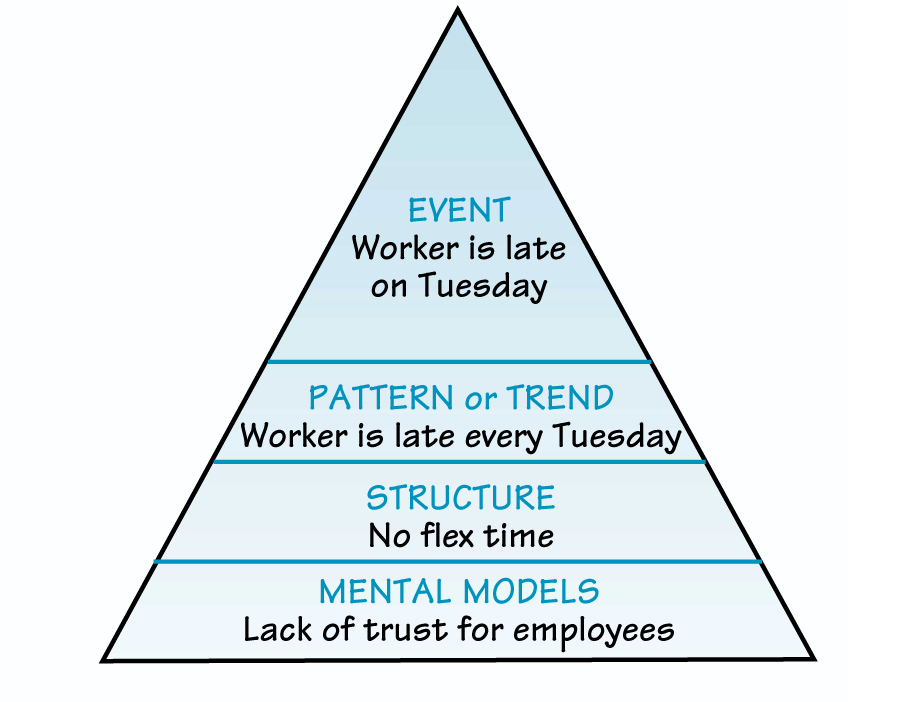

Some of the hidden dynamics were around the power structures underpinning the ideas process: whose ideas were taken seriously and the process by which ideas came to life. Our work is creative, about emotion and passion, but people were detached I was flummoxed as to why people weren’t contributing,” said the meeting owner.

“People weren’t talking and the meetings weren’t functional. One of the ‘hot’ presenting issues was the pickle they were in with their creative meetings.

This example comes from a transformation project I ran for an arts organisation. The conversation often starts with structures and flows into beliefs, and a richer picture emerges.Ĭase study A: finding the place to intervene in an arts organisation “Where do we have permission, agency and appetite to experiment?”
Iceberg model examples how to#
It often triggers new insight about what they’re experiencing and new ideas for how to intervene. A light goes on for people when they see the list of structures, the ‘levers’ they can pull. Its great strength seems to be that it puts the client in the driving seat in a conversation about the interventions to try in their organisation. It’s simple and easy to understand and seems to be at a ‘Mummy Bear’, medium level of abstraction – not so specific that it’s scary and not so vague that it loses all meaning. It uses the metaphor of an iceberg to illustrate that our experiences are deeply influenced by dynamics we cannot easily see: the structures that form the framework within which we operate, and the beliefs we hold about how things work. This model is a very simple representation of a complex system. I have adapted it as I’ve used it with people. The original for this one came from The Systems Thinking Playbook by Linda Booth Sweeney and Dennis Meadows (thanks and respect – it’s a brilliant book). There are many versions of the iceberg model. The iceberg model and why people seem to love it You might find it wonderful and marvel at how it helps people shift to a more systemic way of looking at things. You might balk at its simplicity and the things it omits. You might not love this model if you’re a purist about complexity science or a stickler for precision. It happens every time I share it people love it. I offered a simple iceberg model and my client seized on it, waved it around and started using phrases like “going deeper in the iceberg”. It comes with a simple how-to guide including an example.I had the experience again. I created a handy worksheet to help you put this tool into practice. You now have much more leverage for solving the problem. The tight deadlines are imposed by managers and teams believe it's not their place to push back.Īs you can see, by looking beyond immediate events, you are able to find a root cause of a problem. Investigating further, you discover that teams value shipping on time over the quality of their work. Teams also typically have tight deadlines to ship a feature. Digging deeper, you find that teams don't plan for testing before releasing a feature. If you look back in time, you see that every released feature comes with several bugs. That's obviously not enough if you want to prevent it from happening in the future. Your instinct might be to react to it and start fixing them. Suppose there are a couple of bugs in the feature your product team just released. Let's look at a real-world example to better understand how the iceberg model works. Especially when it comes to the mental models which are hard to document, let alone see in plain sight.Įxample of the Iceberg model by Justin Farrugia Example It's important to note that answering these questions will likely require some research and digging. What values, beliefs or assumptions shape the system?.Where are the connections between patterns?.What has been happening over time? What are the trends?.Here are some questions to help you understand each level within a certain problem or situation. The deeper you can go in the iceberg, the more leverage you'll have. Structures and mental models tell you why it's happening. These structures are in turn based on the underlying mental models of people.Įvents and patterns show you what is happening. Structures are the relationships and feedback loops inside a system. They are the clue for understanding the system structures that are behind those patterns. Looking below individual events, you can see trends over time-patterns. Example of an iceberg model by Justin Farrugia


 0 kommentar(er)
0 kommentar(er)
